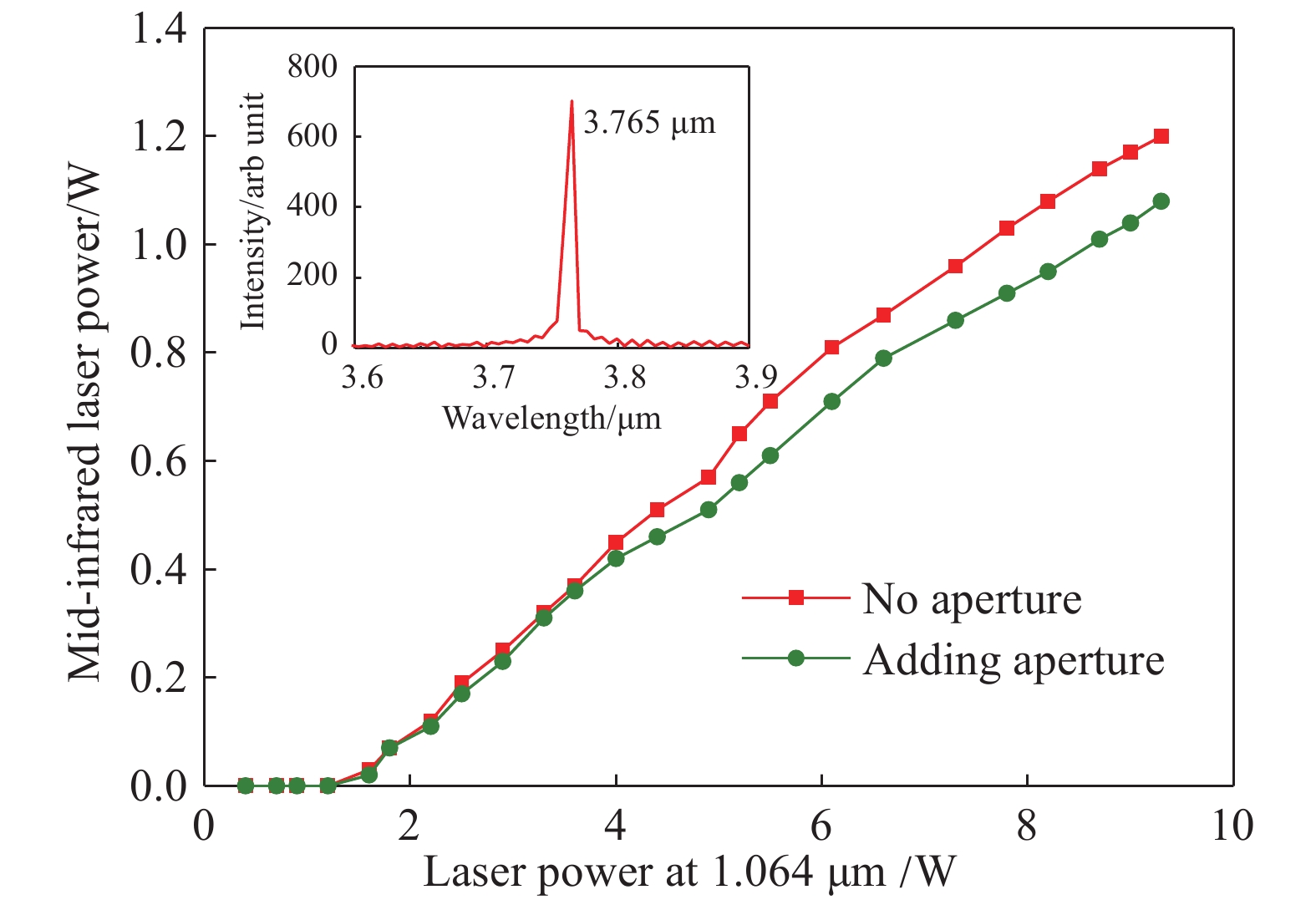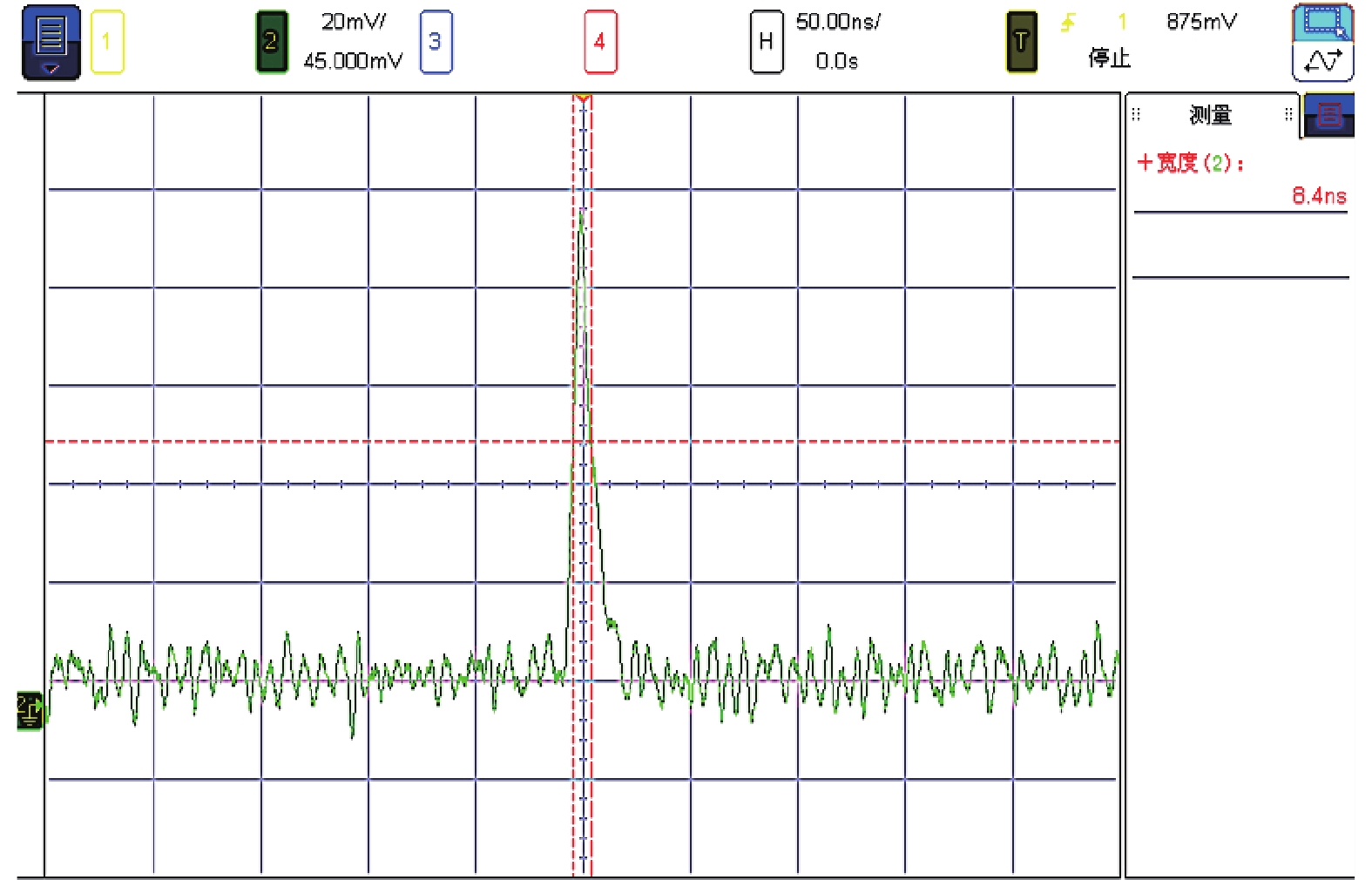-
中红外激光在大气中传输时衰减很小,处于大气红外窗口,而且该波段还位于许多分子的“指纹”区,对应多数分子的特征吸收谱,因此,中红外激光在大气环境监测、遥感测量、光电探测和光电对抗等领域有着重要应用[1-4]。其中,采用波段1 μm激光器泵浦基于MgO:PPLN晶体的光参量振荡器(OPO)可实现中红外激光输出,该OPO具有功率高、效率高、光束质量好和波长可调谐等优点,是实现连续和脉冲中红外激光输出的有效途径[5-7]。通常,基于MgO:PPLN晶体的OPO(MgO:PPLN-OPO)采用光纤激光器或固体激光器作为泵浦源。
掺Yb光纤激光器具备功率高、效率高和散热性能好等优点,可作为MgO:PPLN-OPO的泵浦源。其中,为了提高泵浦光的峰值功率,进而提高OPO的光光转换效率,需采用脉冲掺Yb光纤激光器作为泵浦源。主振荡功率放大(MOPA)结构的掺Yb光纤激光器是获得高峰值功率1 μm波段激光输出的主要技术途径,即通过一级或多级掺Yb光纤放大器对窄脉宽种子光进行功率放大,MOPA光纤激光器作为泵浦源得到了大量实验验证[6, 8-11]。但在工程应用中,MOPA光纤激光器在出光时,若种子源或预放大级出现故障,很容易造成下一级放大器的损坏;而较高的峰值功率易引发光纤内的受激布里渊散射等非线性效应;同时,后向反射光易对光纤激光器造成损伤;此外,为实现线偏振光纤激光输出,需全部采用保偏光纤器件,成本较高。上述因素不利于MOPA光纤激光器在MgO:PPLN-OPO中的工程应用。
固体激光器也可用于泵浦MgO:PPLN-OPO,其中,基于Nd:YVO4晶体的固体激光器易于实现高峰值功率脉冲激光输出,且相比于MOPA光纤激光器,Nd:YVO4激光器结构简单,可直接输出线偏振激光,对后向反射光不敏感,且成本较低,在MgO:PPLN-OPO中得到了应用[12-14]。但Nd:YVO4激光器通常需要水冷散热,水冷机不仅增加了MgO:PPLN-OPO的体积和重量,而且需要定期维护,不利于MgO:PPLN-OPO的工程应用,同时,在高峰值功率泵浦情况下,MgO:PPLN-OPO中的高阶模会产生振荡,降低中红外激光光束质量。因此,文中介绍了一种无水冷Nd:YVO4激光器泵浦的高光束质量MgO:PPLN-OPO,采用声光调Q方法使Nd:YVO4激光器输出高峰值功率脉冲泵浦激光,进而获得高效率、高峰值功率中红外激光输出。在MgO:PPLN-OPO谐振腔中加入光阑,以提高中红外激光光束质量。整个激光器采用热电制冷和风冷相结合的散热方式,极大地缩减了激光器的体积和重量,为MgO:PPLN-OPO的工程应用提供了可行的技术方案。
-
实验装置如图1所示,OPO的泵浦源为声光调Q Nd:YVO4激光器,采用0.879 μm LD端面泵浦,LD泵浦光经光纤耦合输出,由耦合镜组M1和M2准直聚焦后进入Nd:YVO4晶体端面。Nd:YVO4晶体尺寸为3 mm×3 mm×20 mm,固定于冷却热沉中,通过调整Nd:YVO4晶体摆放位置,可实现竖直线偏振1.064 μm激光输出,从而满足MgO:PPLN晶体的相位匹配条件。激光谐振腔由平面二色镜M3和平面输出耦合镜M4组成,M3镀0.879 μm高透、1.064 μm高反膜,M4在1.064 μm处的反射率为70%。在Nd:YVO4晶体和M2之间为声光调制器(AOM),AOM由射频信号驱动,使用方波调制信号控制AOM状态:在方波信号处于低电平状态时,驱动器输出射频信号,声光晶体中产生超声波使光束发生衍射,谐振腔处于高损耗低Q值状态;当方波信号变为高电平状态时,驱动器停止输出射频信号,谐振腔处于低损耗高Q值状态,形成激光振荡,引发激光脉冲输出。
Nd:YVO4激光器输出的竖直线偏振1.064 μm激光经过45°反射镜M5和M6反射后入射OPO。OPO主要包括缩束镜组、谐振腔镜、MgO:PPLN晶体、加热炉、扩束镜组和分束镜等。泵浦光首先经过缩束镜组M7和M8压缩光斑直径,以提高泵浦光功率密度,进而提高OPO的光光转换效率。MgO:PPLN 晶体(HCP公司)尺寸为 50 mm×3 mm×2 mm,MgO掺杂浓度为5 mol%,极化周期为29.5 μm,晶体端面镀1.064 μm、1.480 μm和3.800 μm增透膜。MgO:PPLN 晶体固定在加热炉中,工作温度设定在65 ℃,温控精度为±0.1 ℃,对应的信号光和闲频光波长分别为1.480 μm 和3.800 μm。谐振腔由平镜M7和M8组成,采用信号光单谐振方案,M7镀1.064 μm高透、1.480 μm或3.800 μm高反膜,M8镀1.064 μm高反、3.800 μm高透和1.480 μm部分反射膜(反射率70%),谐振腔腔长为100 mm,MgO:PPLN晶体放置在谐振腔的中心位置,在MgO:PPLN晶体和M8之间放置孔径1 mm光阑,以抑制高阶模的振荡,从而优化输出激光的光束质量。泵浦光入射MgO:PPLN晶体后,在谐振腔的反馈下,通过光学参量振荡过程,获得近红外波段的信号光和中红外波段的闲频光输出,由于中红外激光发散角较大,需通过扩束镜组M11和M12进行扩束以压缩发散角,再利用分光镜M13将信号光滤除,最终获得中红外激光输出。
在热控方面,该中红外OPO采用半导体热电制冷器(TEC)和风冷相结合的散热方式,其主要热源器件包括LD、Nd:YVO4晶体和AOM。如图2所示,对于LD和Nd:YVO4晶体,其温度需稳定在20 ℃,因此通过TEC对LD和Nd:YVO4晶体温度进行精确控制,温控精度可达±0.1 ℃,TEC将热量导入铝合金底板和散热翅片,通过风冷对底板和散热翅片进行散热。AOM则采用热传导的方式,将热量导入铝合金底板和散热翅片,并通过风冷散热。对于MgO:PPLN晶体,为防止加热炉热量导入铝合金底板,采用聚四氟乙烯对其进行隔热。
-
首先对声光调Q Nd:YVO4激光器的输出特性进行了实验研究。采用方波信号对AOM进行调制,方波信号重复频率为30 kHz,幅值为5 V,占空比为1%,Nd:YVO4激光器输出1.064 μm脉冲激光,采用格兰棱镜将输出激光分为竖直偏振和水平偏振的线偏振激光,采用激光功率计(Ophir公司FL150A-BB-26型)分别对激光功率进行测试,结果如图3所示。可见,激光功率随泵浦功率呈线性增长,且竖直激光偏振分量远远大于水平偏振分量,在LD最高功率为34.2 W情况下,竖直偏振和水平偏振激光最高分别为9.3 W和0.4 W,偏振消光比>13 dB,不考虑水平偏振分量,Nd:YVO4激光器的光光转换效率为27.2%。
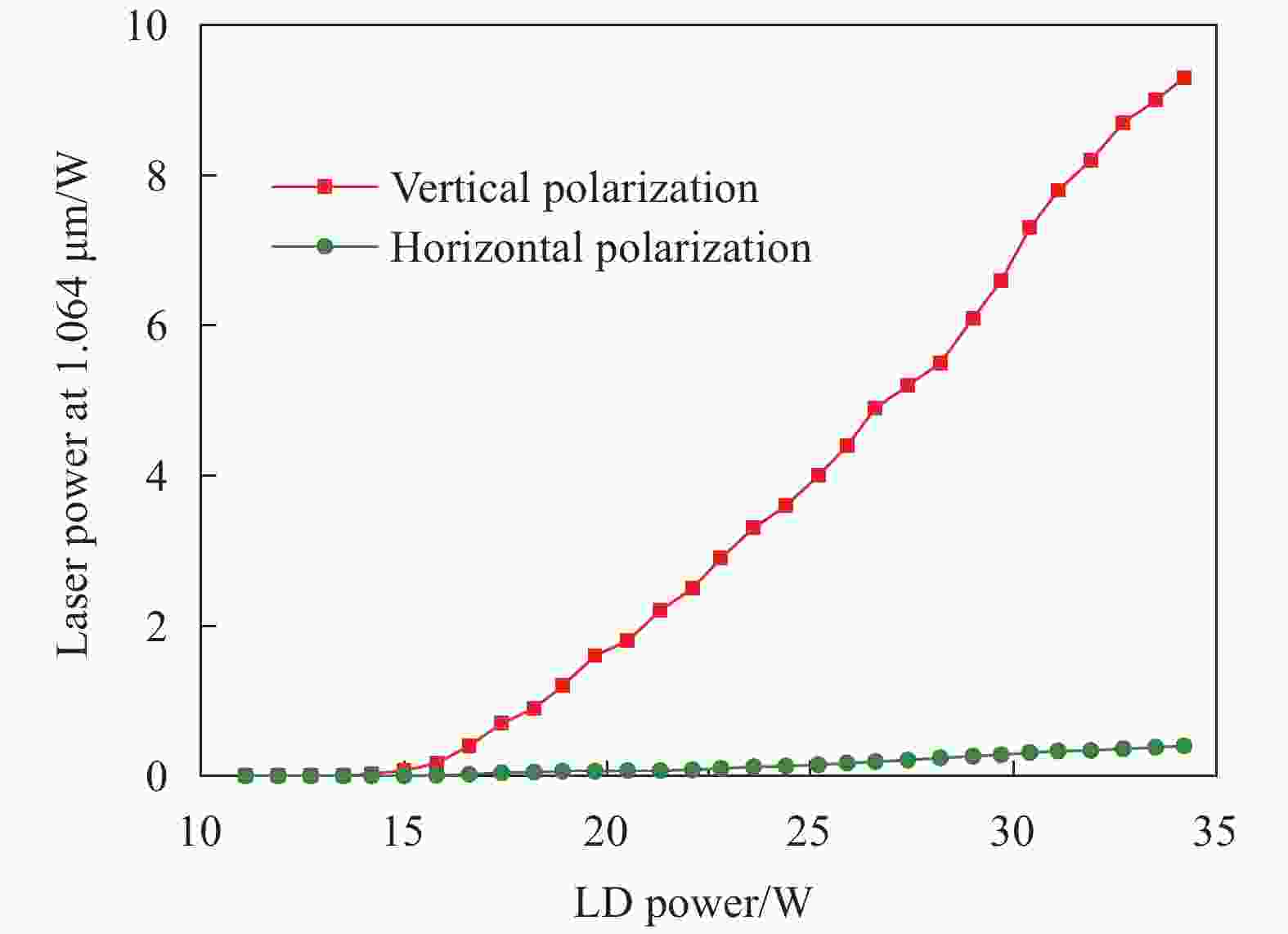
Figure 3. Output power of the vertically and horizontally polarized laser at 1.064 μm as a function of LD power
如图4所示为Nd:YVO4激光器在最高输出功率情况下,使用光电探测器(滨松公司C5658型)和示波器(Agilent公司DSO-X 3024A型)测得的1.064 μm激光脉冲波形图。由图4可知,激光重复频率与方波信号一致,均为30 kHz,激光脉冲宽度为11.3 ns,因此,在最高输出功率情况下,1.064 μm激光的峰值功率可达~27.5 kW。采用刀口法对Nd:YVO4激光器的光束质量进行了测量,在激光输出功率为9.3 W时,水平方向Mx2因子与竖直方向My2因子分别为1.41和1.52。
-
采用上述声光调Q Nd:YVO4激光器泵浦MgO:PPLN-OPO。为了获得高光束质量中红外激光输出,在OPO谐振腔中加入了光阑。如图5所示为无光阑和有光阑情况下中红外激光光谱和功率随1.064 μm泵浦光功率变化曲线。可见,当泵浦功率低于4 W时,有光阑和无光阑情况下的阈值泵浦功率均为~1.6 W,且中红外激光功率相差较小,因为在泵浦功率较低时,谐振腔中的高阶模成分较少,光阑对光参量振荡过程影响较小。但随着泵浦功率的增加,谐振腔中的高阶模开始振荡,加入光阑可对高阶模的振荡进行抑制,并提高低阶模的转换效率,但是中红外激光功率会出现一定程度的下降。采用中红外傅里叶光谱仪(Arcoptix公司FIT-MIR 2−6型,波长分辨率~0.006 μm)对中红外激光光谱进行测量,在最高泵浦功率为9.3 W时,激光峰值波长为3.765 μm,无光阑和有光阑情况下,中红外激光功率分别为1.20 W和1.08 W,相应的光光转换效率分别为12.9%和11.6%。
虽然加入光阑后中红外激光的光光转换效率出现少量下降,但中红外激光的光束质量可获得较大提高。如图6所示为中红外激光功率达到最大值时,采用刀口法对中红外激光M2因子进行测试的结果。可见,在无光阑情况下,水平方向Mx2因子与竖直方向My2因子分别为1.89和1.98,而在加入光阑后,中红外激光的Mx2因子和My2因子分别为1.20和1.29,这说明光阑有效地抑制了高阶模产生,能够提高中红外激光的光束质量,加入光阑后的中红外激光光斑轮廓图如图6(b)所示。
采用HgCdTe光电探测器(Vigo公司PV-2TE-4型)和示波器(Keysight公司DSO-X 4104A型)对中红外激光脉冲波形进行测试,如图7所示为加入光阑情况下,中红外激光功率为1.08 W时的脉冲波形图。可见,当重复频率为30 kHz时,中红外激光的脉冲宽度可达8.4 ns,相应的中红外脉冲激光的峰值功率可达~4.3 kW。上述结果表明,通过在谐振腔中加入光阑,在提高MgO:PPLN-OPO光束质量的同时,还可实现高效率、高峰值功率中红外激光输出。
-
文中介绍了声光调Q Nd:YVO4激光器泵浦MgO:PPLN-OPO的结构和工作原理,该中红外激光器采用热电制冷和风冷相结合的散热方式,并通过在OPO谐振腔中加入光阑对中红外激光的光束质量进行了优化。实验结果表明:采用无水冷的声光调Q Nd:YVO4激光器能够实现最高9.3 W的脉冲激光输出,光光转换效率为27.2%,峰值功率可达~27.5 kW;在Nd:YVO4激光器泵浦下,在无光阑情况下,MgO:PPLN-OPO可实现最高1.20 W的3.765 μm激光输出,Mx2和My2因子分别为1.89和1.98,在谐振腔中加入光阑后,MgO:PPLN-OPO的最高输出功率略降至1.08 W,但光束质量有明显提高,Mx2和My2因子分别为1.20和1.29,同时,激光峰值功率可达~4.3 kW。上述结果证明了热电制冷和风冷能够对Nd:YVO4激光器进行有效地热控,通过在MgO:PPLN-OPO谐振腔中加入光阑不仅能够提高中红外激光光束质量,还可实现高效率、高峰值功率中红外激光输出。此外,声光调Q Nd:YVO4激光器和MgO:PPLN-OPO的输出功率均随泵浦功率的增加呈线性增长,因此若进一步提高泵浦功率,有望实现数瓦级的高功率中红外激光输出。上述实验方案为研制工程化中红外MgO:PPLN-OPO提供了可行的技术途径。
Miniaturized mid-infrared MgO: PPLN optical parametric oscillator with high beam quality
doi: 10.3788/IRLA20190512
- Received Date: 2020-04-02
- Rev Recd Date: 2020-05-16
- Available Online: 2020-07-23
- Publish Date: 2020-07-23
-
Key words:
- OPO /
- MgO: PPLN crystal /
- mid-infrared laser /
- beam quality /
- miniaturized
Abstract: In order to meet the engineering application of mid-infrared laser, a miniaturized mid-infrared MgO: PPLN optical parametric oscillator (MgO: PPLN-OPO) with high beam quality was presented. The pump source was an acousto-optical Q-switched Nd: YVO4 laser. By pumping the MgO: PPLN crystal, the mid-infrared laser with high efficiency and high peak power was obtained. And the mid-infrared beam quality was improved by adding an aperture in the cavity. The whole laser was cooled by thermoelectric cooling and air cooling. Therefore, the size of the laser was miniaturized. Experimental results indicate that the acousto-optical Q-switched Nd: YVO4 laser can realize the pulse laser with the highest power of 9.3 W at 1.064 μm. The corresponding optical to optical conversion efficiency is 27.2% and the peak power is ~27.5 kW. With the Nd: YVO4 laser pump, the MgO: PPLN-OPO can output the pulse laser at 3.765 μm. When adding the aperture in the cavity, the maximum output power of the MgO: PPLN-OPO decreases from 1.20 W to 1.08 W. However, the beam quality improves obviously. The Mx2 and My2factors change from 1.89 and 1.98 to 1.20 and 1.29, respectively. The pulse width and the peak power of mid-infrared laser are 8.4 ns and ~4.3 kW, respectively.



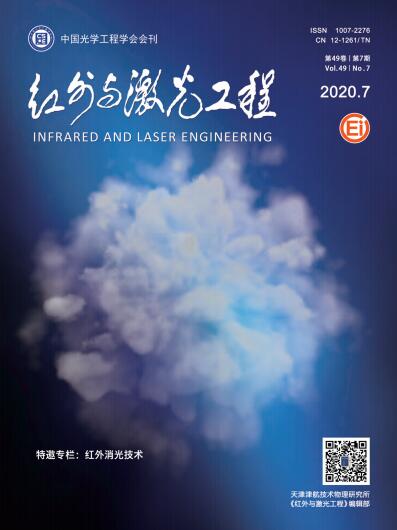


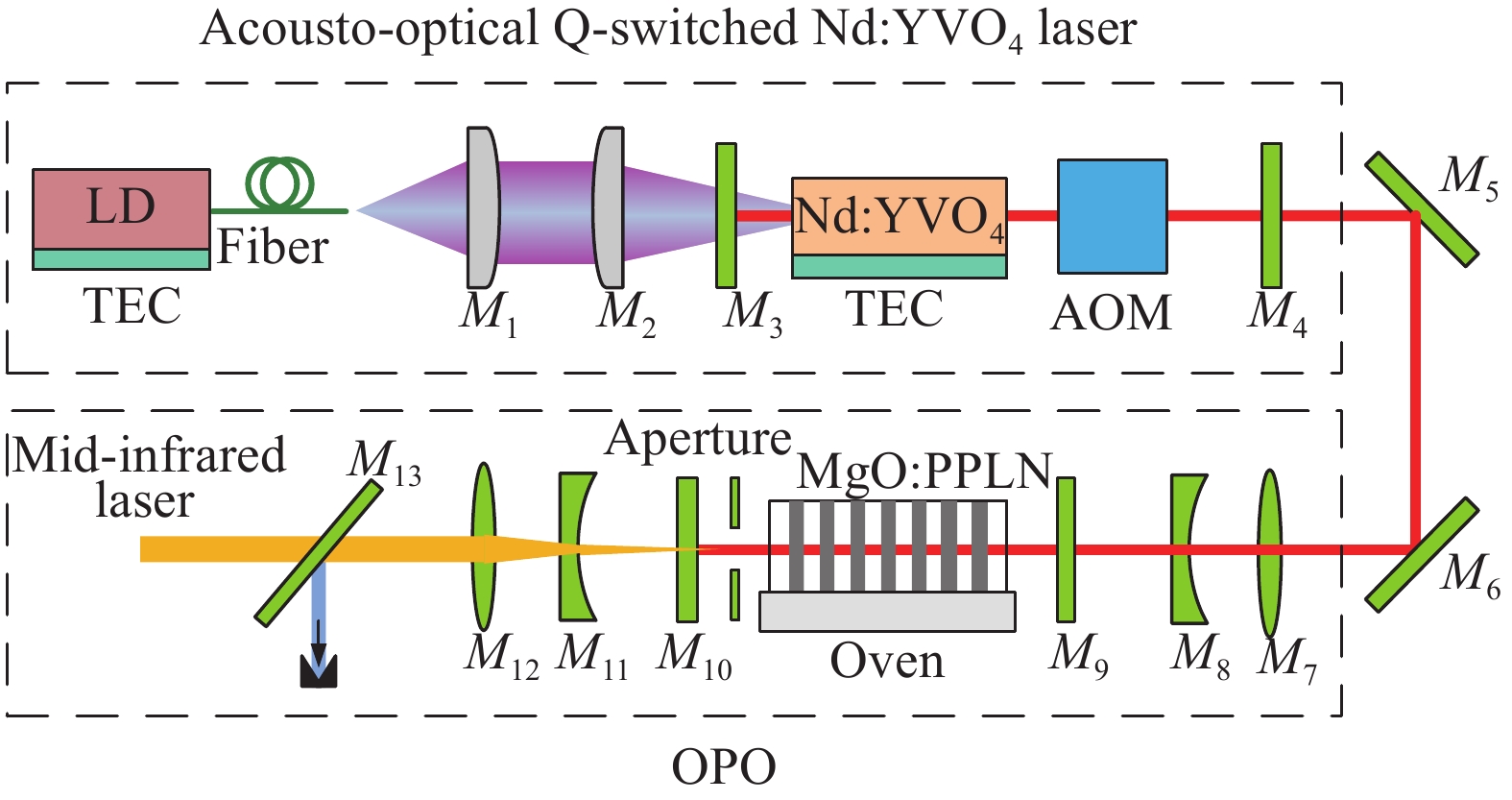


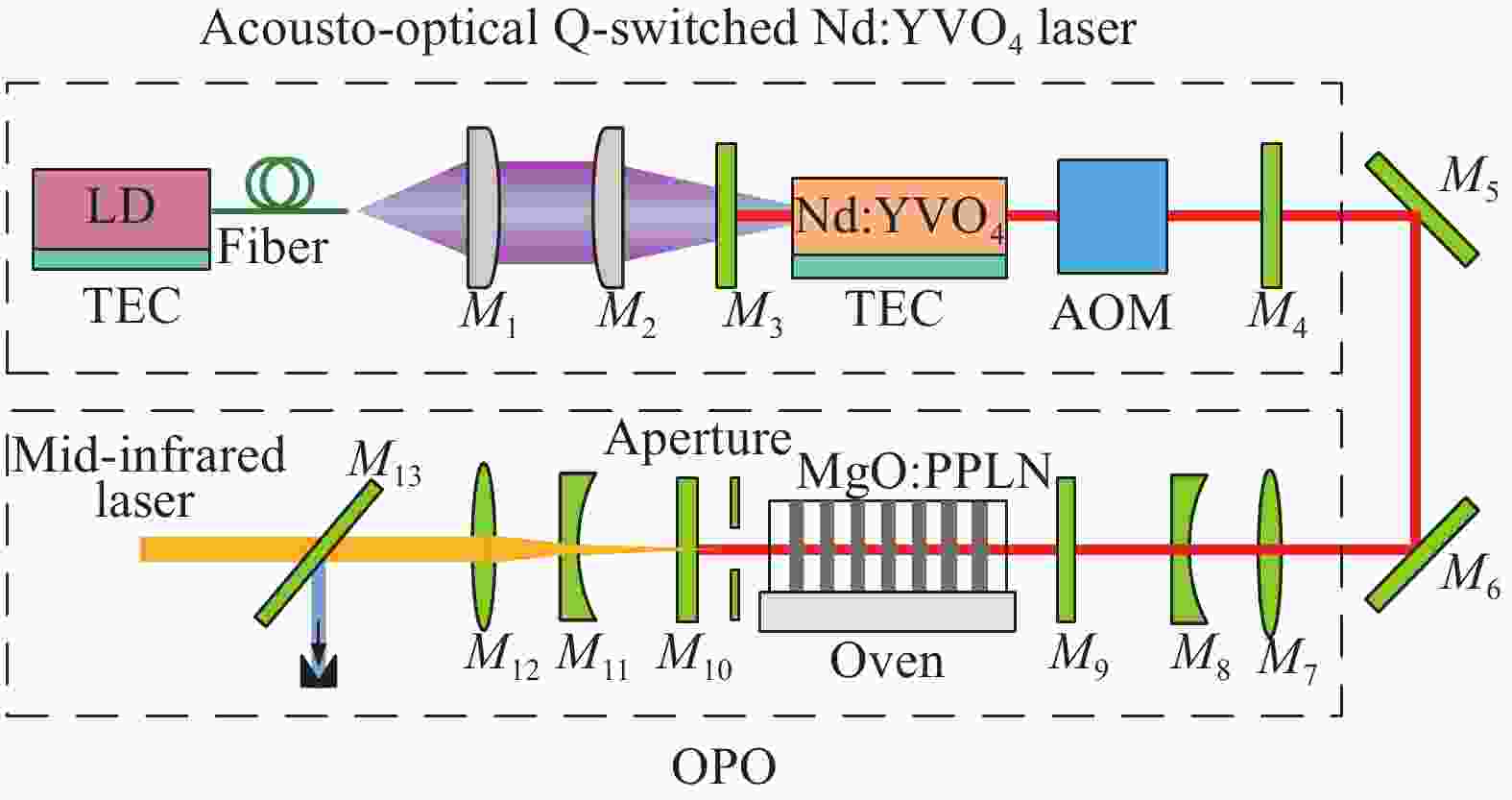

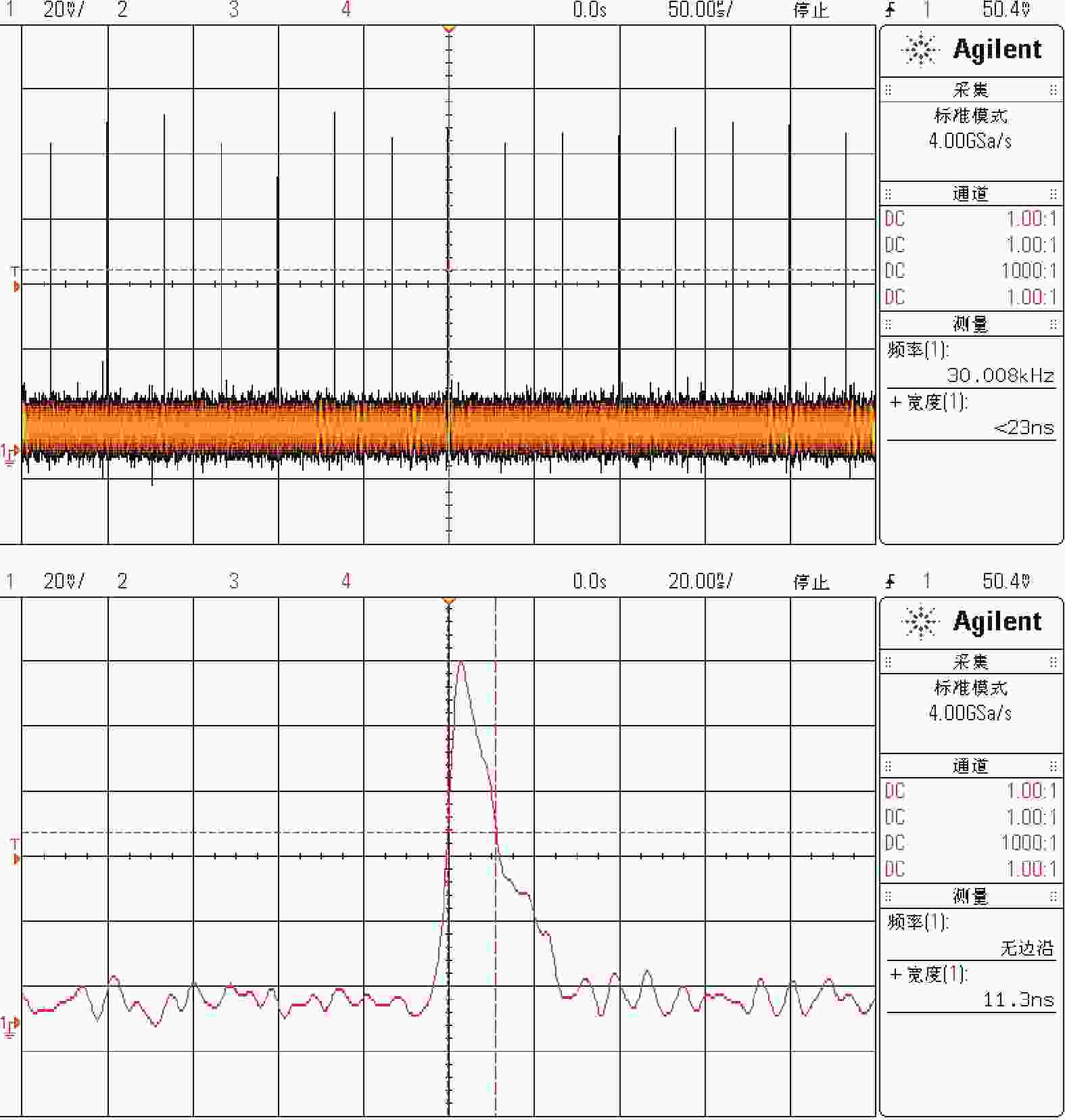
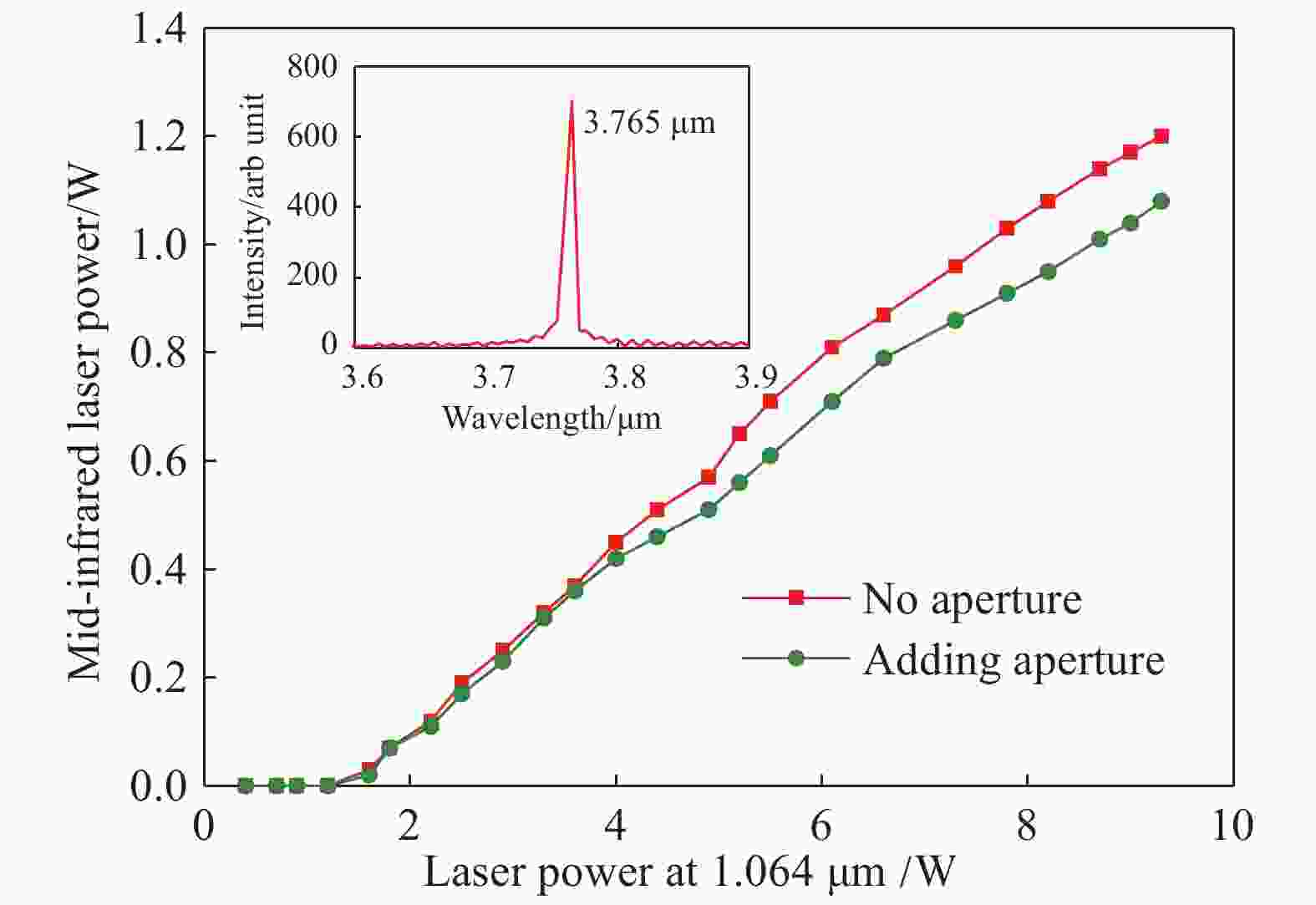
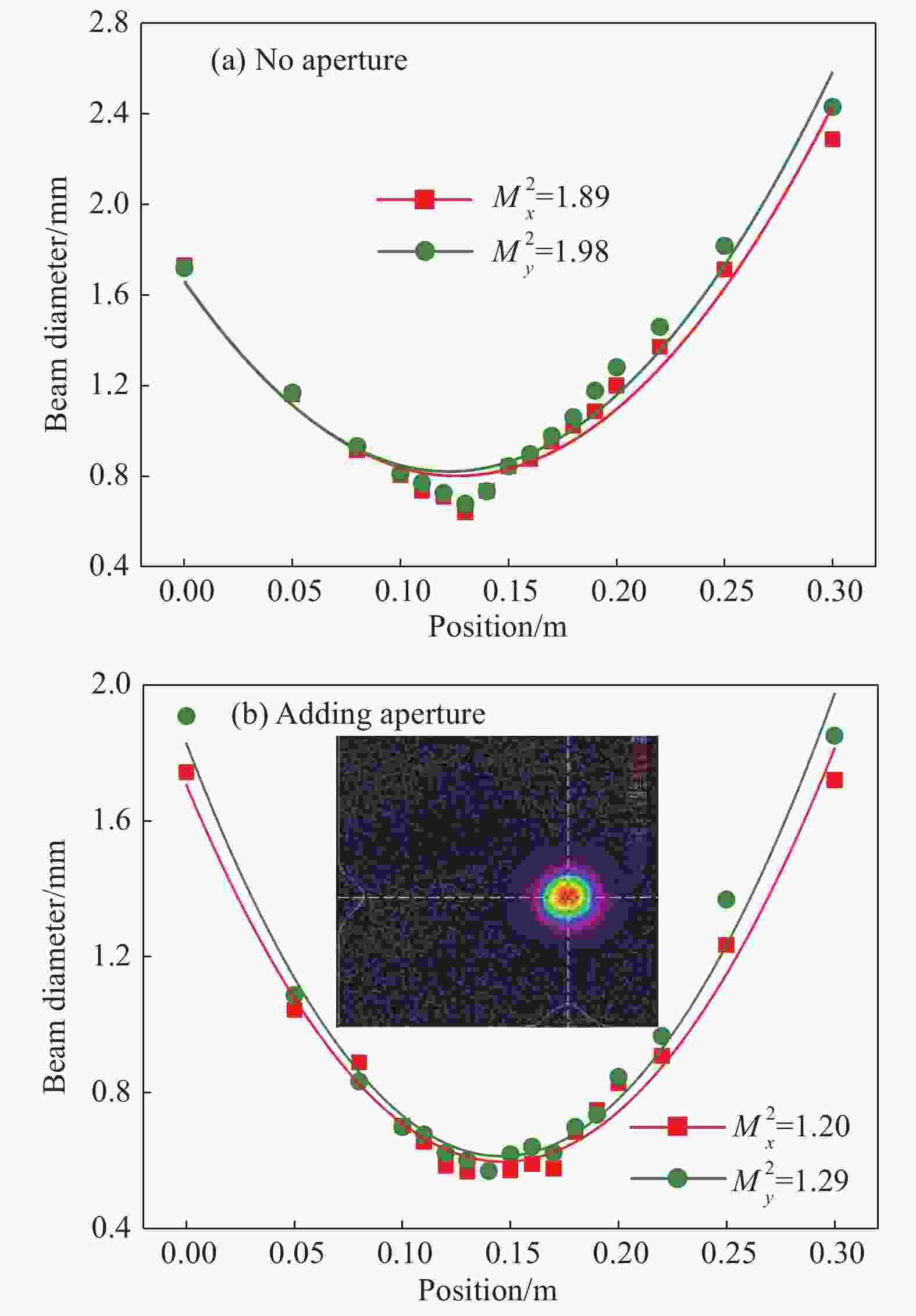


 DownLoad:
DownLoad:



